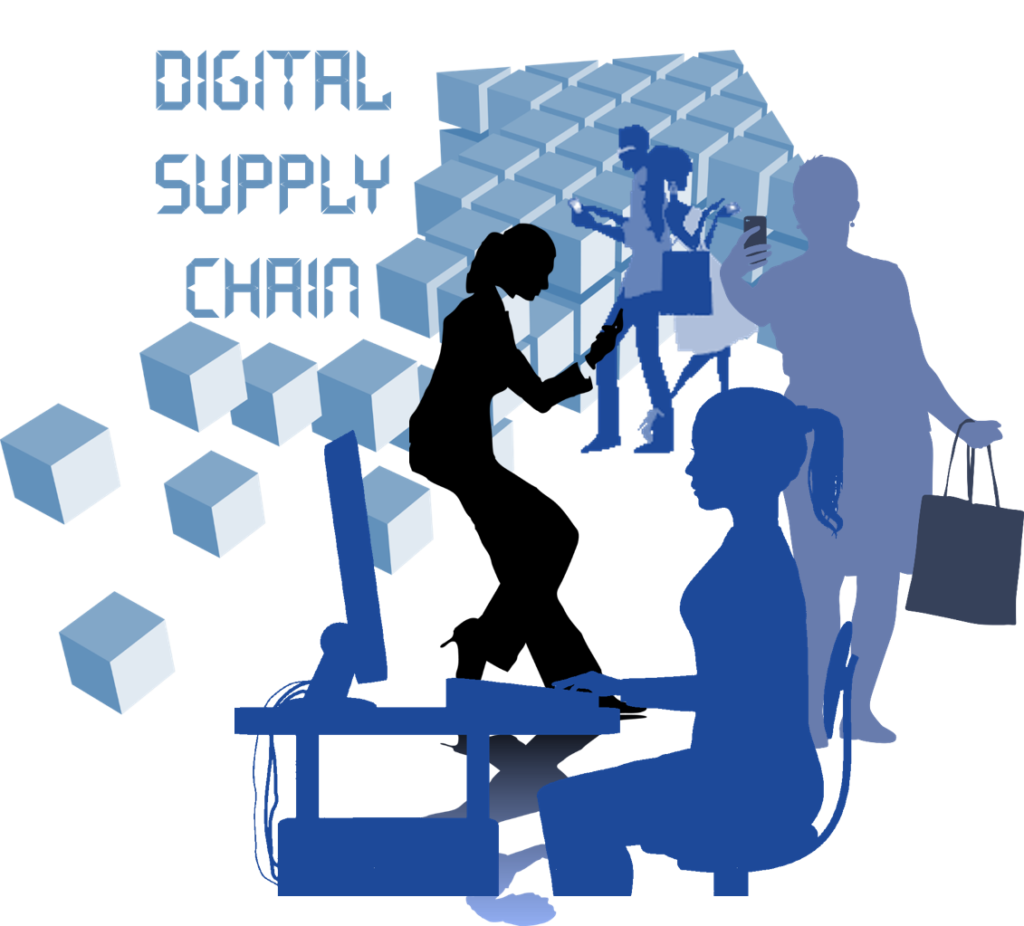The 2017 holiday season once again highlighted the increasing role the digital path to purchase is playing in the retail arena. Albert Chiang, Oracle’s Director of Product Marketing, insists this shift in consumer habits is forcing businesses to transform their supply chains. He explains, “The transformation is driven by the ‘digital native’ customer experience, and a digital transformation is the change agent needed to make this happen.”[1] He believes three technologies will play a significant role in implementing a digital supply chain: the Internet of Things (IoT); artificial intelligence (AI); and blockchain.
Digital Supply Chain Technologies
Internet of Things
You read and hear a lot about the IoT nowadays. There is a growing consensus it will change how the world works — if all current challenges and shortcomings can be worked out. In the supply chain arena, Jessica Twentyman (@jtwentyman) asserts, “Speed, security and mode of delivery could be revolutionized by the internet of things.”[2] She explains, “When goods in transit can ‘talk’ to supply chain managers, it is easier to figure out where they are, what state they are in and their likely time of arrival at a destination. The same applies to the vehicles or robots that transport them, which is why new levels of internet of things (IoT) connectivity are encouraging supply chain companies to invest to get products to the right place, faster and in good condition.” Chiang agrees. He writes, “IoT has massive implications for supply chain management, including manufacturing, inventory management, and logistics. For Manufacturing — production managers can track output levels & yields of production across the globalized manufacturing base instantly — handy when you have hundreds of production lines spread throughout China, Mexico, and Turkey. For Inventory — supply chain organizations have the ability to instantly look up the supply levels across the planet of every SKU and its precise location. For Logistics — workers track in real time not only where the delivery is, but the state (temperature, humidity, vibration) of the product — needed if you are delivering fresh Dutch tulips across the planet.”
Artificial Intelligence
When people talk about the IoT, what they most often are referring to is an ecosystem at whose heart lies the IoT. The ecosystem consists of sensors that generate data (oceans of it), the IoT that transmits that data, and advanced analytics platforms (i.e., cognitive computing systems) that make sense of the data. Adrian Gonzalez (@talkinlogistics) explains, “The most important thing to understand is that when we talk about AI and machine learning what we’re really talking about is a fundamentally different type of computing than has existed before. If you want to simplify it, the analogy I often use is that it’s the difference between a smartphone and a flip phone … It is a type of computing technology that is a necessary co-pilot to making the very complex decisions we make every day, whether it’s personally using a smartphone to navigate the world in traffic, or in the supply chain to navigate all of the exceptions and contingencies that go awry when you’re dealing on a global scale.”[3]
The point here is that the IoT is going to generate so much data that only a cognitive computing system will be capable of analyzing it. As a result of that analysis, actionable insights can be provided to decision makers and/or autonomous decisions can be made by the platform. Irving Wladawsky-Berger, a former IBM executive, suggests real-time big data and analytics could be the most important part of the digital supply chain. He explains, “The most important factor enabling the ability to flip to the customer-facing front side are the massive amounts of data now at our disposal from a wide variety of sources, including mobile devices, sensors, IoT systems, and social media, along with the sophisticated tools being developed to collect, analyze and use the data. These data and tools will enable companies to make better decisions across the overall supply chain, including product design, manufacturing, distribution and sales.”[4]
Blockchain
One reason pundits are excited about blockchain technology is because it can eliminate middlemen — making supply chains more effective and efficient. Sarah Wray believes this will lead to a decentralized economy that will dramatically change how the supply chain works. She explains, “This decentralized economy, underpinned by blockchain, will not only impact how we trade but will also radically change how we make, design and produce physical and digital goods.”[5] Wray discusses a talk given by Bettina Warburg, co-founder and managing partner of Animal Ventures, during which Warburg explained, “Throughout history, we have created ‘middlemen’ to deal with uncertainty about trade — who are we dealing with, how do we know we are getting what we were promised, and what if we don’t receive the goods? These middlemen include banks, corporations and government entities, as well as online platform marketplaces like Amazon, eBay and Alibaba. Now for the first time, she said, we can lower this uncertainty using technology alone — blockchain, meaning no middlemen are required.”
Wladawsky-Berger adds, “Blockchain technologies hold great promise for digital supply chains over time, increasing the speed, security and accuracy of financial and commercial settlements; tracking the supply chain lifecycle of any component or product; and securely protecting all the transactions and data moving through the supply chain.” Chiang agrees. He writes, “Blockchain has the potential to bring a new dimension of visibility to supply chain management — one that can bring ethical, social, and safety changes to supply chain management.”
The Digital Supply Chain and Consumers
The logic behind the need for a digital supply chain is compelling. We live in the Digital Age populated by digital natives who are increasingly utilizing the digital path to purchase. Wladawsky-Berger cites a paper drafted by the Digital Supply Chain Institute that insists managing consumer demand requires real-time continuous engagement with customers. The paper concludes, “Executing the frontside flip is difficult for supply chain organizations that have focused exclusively on procurement, manufacturing, shipping and logistics. … In the near future, winning companies will use artificial intelligence to match demand and supply. Inventory will be reduced by as much as 30% as companies build algorithms that automatically replenish based on observable demand signals.” The increased importance of the consumer digital path to purchase has forced businesses to develop omnichannel strategies. These strategies have put new strains on supply chains making digital transformation an even more urgent imperative.
Summary
In addition to IoT, AI, and blockchain, Wladawsky-Berger suggest three other game-changers are making digital transformation an imperative. They are:
Digital Manufacturing and Delivery. “Several breakthrough technologies will have a major impact on manufacturing and delivery over the next several years. Foremost among them is the emerging robotics revolution. Robots are computers that have both a brain and a body. … 3D printing is another promising technology with the potential to significantly impact the supply chains of a growing number of industries, including medical devices, automotive and retail. So are drones, which are already being deployed in infrastructure maintenance, security, assets monitoring and other tasks across a number of industries.”
Purposeful Collaboration. “Collaborative software or groupware, designed to help people work closely together to achieve a common goal, is critically important for an integrated supply chain to succeed. Purposeful collaborations are the only way to reconcile the competing goals and objectives of the various participants in a supply chain, both within the different departments of a company, as well as across the external ecosystem of partners.”
Addressing Risks. “Information sharing and transparency enhance the capacity to see and address risks in a digital supply chain, including cyber attacks, IP theft, and compliance issues.”
Since each supply line is unique, digital supply chains will also be unique. Nevertheless, they will all involve the technologies mentioned above and will be customer focused.
Footnotes
[1] Albert Chiang, “The Transformation of Supply Chain Management – IoT, AI, & Blockchain,” Oracle Supply Chain Management Blog, 27 November 2017.
[2] Jessica Twentyman, “Smart links in the supply chain show they can deliver,” Financial Times, 1 November 2017.
[3] Adrian Gonzalez, “Using Intelligence Over Scale: The Power of AI and Machine Learning in Supply Chain and Logistics,” Talking Logistics, 16 October 2017.
[4] Irving Wladawsky-Berger, “Digital Supply Chains of the Future Will Focus on the Customer,” The Wall Street Journal, 27 October 2017.
[5] Sarah Wray, “The decentralized economy is inevitable. Cities now need to prepare for impact,” Smart Cities Dive, 28 November 2017.





